Churchill River (Hudson Bay)
The Churchill River (French: Rivière Churchill)[1][3] is a major river in Alberta, Saskatchewan and Manitoba, Canada. From the head of the Churchill Lake it is 1,609 kilometres (1,000 mi) long.[2] It was named after John Churchill, 1st Duke of Marlborough and governor of the Hudson's Bay Company from 1685 to 1691.
| Churchill River | |
|---|---|
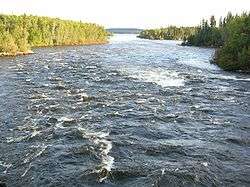 Otter Rapids (Churchill River) | |
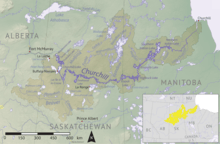 Churchill River Basin in Canada | |
| Etymology | Named after John Churchill, 1st Duke of Marlborough |
| Native name | Missinipi |
| Location | |
| Country | Canada |
| Provinces | |
| Physical characteristics | |
| Source | Churchill Lake |
| • location | Saskatchewan |
| • coordinates | 56°6′22″N 108°14′46″W |
| Mouth | Hudson Bay |
• location | Manitoba |
• coordinates | 58°47′45″N 94°12′15″W[1] |
| Length | 1,609 km (1,000 mi)[2] |
| Basin size | 281,300 km2 (108,600 sq mi)[2] |
| Discharge | |
| • average | 1,200 m3/s (42,000 cu ft/s) |
The Cree name for the river is Missinipi, meaning "big waters".[4]
The river is located entirely within the Canadian Shield. The drainage basin includes a number of lakes in Central-East Alberta which flow into a series of lakes in Saskatchewan and Manitoba. The main tributary, the Beaver River, joins at Lac Île-à-la-Crosse.
Nistowiak Falls—the tallest falls in Saskatchewan—are on the Rapid River, which flows north, out of Lac la Ronge into Nistowiak Lake on the Churchill just north of La Ronge.
A large amount of flow of the Churchill River after Manitoba–Saskatchewan border comes from the Reindeer River, which flows from Wollaston and Reindeer lakes. Flow from Reindeer Lake is regulated by the Whitesand Dam. From there, the Churchill River flows east through a series of lakes (Highrock, Granville, Southern Indian and Gauer), then flows via a diversion for hydro-electric generation into the Nelson River (60% of flow), and the rest flows as the Churchill River into Hudson Bay at Churchill, Manitoba (see also Nelson River Hydroelectric Project).[5]
History
The Churchill formed a major part of the "voyageur highway" in the 18th to 20th centuries after Dene people showed Peter Pond the Methye Portage which connects the Hudson Bay watershed with the Clearwater – Athabasca – MacKenzie rivers which flow to the Arctic Ocean.[6] See Canadian Canoe Routes (early).
Fish species
The Churchill is also home of several fish species including: walleye, sauger, yellow perch, northern pike, lake trout, lake whitefish, cisco, white sucker, shorthead redhorse, longnose sucker, lake sturgeon and burbot.
Hydroelectric Developments
Island Falls
The only operating hydroelectric generating station on the Churchill River is Island Falls, with a capacity of 111MW. The purpose of the Whitesand Dam mentioned above is to control the amount of water flowing through Island Falls, since the generating station is downstream of the Reindeer River fork.
Wintego Hydroelectric Project
In the 1970s, SaskPower was considering building another hydroelectric station on the Churchill River called Wintego. This station would've been located 14 miles downstream of the Reindeer River forks, and 20 miles upstream of Island Falls. The project was expected to cost $338 million (equivalent to $1.3 billion in 2020),[7] including transmission and roads, and the capacity of the station would've been 300MW.
The cost estimate assumes a 50 year lifespan, but the lifespans of SaskPower's other hydroelectric stations have been proven to be much longer (such as 90 years for Island Falls). Construction of Wintego would also enable the output of Island Falls to increase by 70MW, and this benefit is not included in the cost estimate above.[8]
Other Saskatchewan
Two other potential hydroelectric developments between the Reindeer River Fork and Island Falls are the Iskwatam Generating Station and the Pita Generating Station, with unknown MW capacities.[9]
Manitoba
In Manitoba, the Bonald and Granville Falls generating stations could produce 110MW and 120MW, respectively.
Photos
- Churchill Lake viewed from Buffalo Narrows
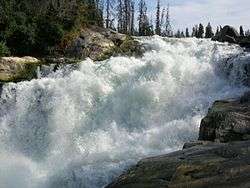 View of upper Nistowiak Falls
View of upper Nistowiak Falls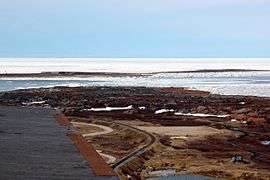 Mouth of the Churchill River at Hudson Bay
Mouth of the Churchill River at Hudson Bay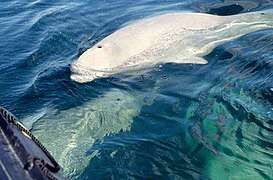
References
- "Churchill River". Geographical Names Data Base. Natural Resources Canada. Retrieved August 29, 2014.
- "Principal rivers and their tributaries". Statistics Canada. February 2, 2005. Archived from the original on September 9, 2006. Retrieved 2010-01-13.
- "Names of pan-Canadian significance". Natural Resources Canada – Mapping Services. Archived from the original on December 10, 2009. Retrieved January 13, 2010.
- "Churchill River (Manitoba)". The Canadian Encyclopedia
- "Churchill River". Encyclopedia of Saskatchewan. Canadian Plains Research Centre. 2006. Archived from the original on October 7, 2011. Retrieved January 13, 2010.
- "La Loche". The Canadian Encyclopedia. Retrieved July 28, 2008.
- "Inflation Calculator". www.bankofcanada.ca. Retrieved April 19, 2020.
- McClement, J.R.; Campbell, E.B. (1977). "Hydro Electric Potential of the Saskatchewan and Churchill River Basins, Saskatchewan". Canadian Water Resources Journal.
- Saskatchewan, Government of (March 2003). "Amisk-Atik Integrated Forest Land Use Plan". Ministry of Environment. Retrieved April 19, 2020.